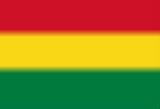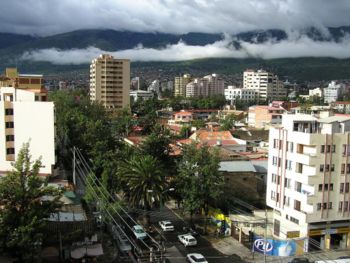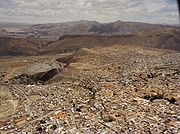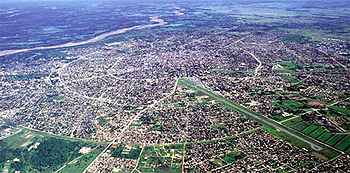
Water supply and sanitation in Bolivia
Encyclopedia
| Bolivia Bolivia Bolivia officially known as Plurinational State of Bolivia , is a landlocked country in central South America. It is the poorest country in South America... : Water and Sanitation |
||
|---|---|---|
 | ||
| Data | ||
| Water coverage (broad definition) | 86% | |
| Sanitation coverage (broad definition) | 25% | |
| Continuity of supply (%) | n/a | |
| Average urban water use (l/c/d) | n/a | |
| Average urban water tariff (US$/m3) | n/a | |
| Share of household metering | n/a | |
| Share of collected wastewater treated | 25% (2000) | |
| Annual investment in WSS | US$3.7/capita (2006) | |
| Share of self-financing by utilities | Close to zero | |
| Share of tax-financing | 42% (1994–2002) | |
| Share of external financing | 58% (1994–2002) | |
| Institutions | ||
| Decentralization to municipalities | Yes | |
| National water and sanitation company | No | |
| National water and sanitation regulator | Yes | |
| Responsibility for policy setting | Ministry of Water | |
| Sector law | Water and Sanitation Services Law #2066 (2000) | |
| Number of urban service providers | n/a | |
| Number of rural service providers | n/a | |
| All values, unless otherwise stated, are in US dollars United States dollar The United States dollar , also referred to as the American dollar, is the official currency of the United States of America. It is divided into 100 smaller units called cents or pennies.... |
||
Bolivia
Bolivia
Bolivia officially known as Plurinational State of Bolivia , is a landlocked country in central South America. It is the poorest country in South America...
’s water and sanitation
Sanitation
Sanitation is the hygienic means of promoting health through prevention of human contact with the hazards of wastes. Hazards can be either physical, microbiological, biological or chemical agents of disease. Wastes that can cause health problems are human and animal feces, solid wastes, domestic...
coverage has greatly improved since 1990 due to a considerable increase in sectoral investment. However, the country continues to suffer from what happens to be the continent’s lowest coverage levels as well as from low quality of services. Political and institutional instability have contributed to the weakening of the sector’s institutions at the national and local levels. Two concessions to foreign private companies in two of the three largest cities - Cochabamba
Cochabamba
Cochabamba is a city in central Bolivia, located in a valley bearing the same name in the Andes mountain range. It is the capital of the Cochabamba Department and is the fourth largest city in Bolivia with an urban population of 608,276 and a metropolitan population of more than 1,000,000 people...
and La Paz
La Paz
Nuestra Señora de La Paz is the administrative capital of Bolivia, as well as the departmental capital of the La Paz Department, and the second largest city in the country after Santa Cruz de la Sierra...
/El Alto
El Alto
At one time merely a suburb of adjacent La Paz, Bolivia, on the Altiplano highlands, the city of El Alto is today one of Bolivia's largest and fastest-growing urban centers. As of the 2001 census, the population was 649,958. In 2010, the population may be nearly 900,000, or more. The city contains...
– were prematurely ended in 2000 and 2006 respectively. The country’s second largest city, Santa Cruz de la Sierra
Santa Cruz de la Sierra
Santa Cruz de la Sierra, commonly known as Santa Cruz, is the capital of the Santa Cruz department in eastern Bolivia and the largest city in the country...
, relatively successfully manages its own water and sanitation system by way of cooperatives. The government of Evo Morales intends to strengthen citizen participation within the sector. Increasing coverage requires a substantial increase of investment financing.
According to the government the main problems in the sector are: low access to sanitation throughout the country; low access to water in rural areas; insufficient and ineffective investments; a low visibility of community service providers; a lack of respect of indigenous customs; "technical and institutional difficulties in the design and implementation of projects"; a lack of capacity to operate and maintain infrastructure; an institutional framework that is "not consistent with the political change in the country"; "ambiguities in the social participation schemes"; a reduction in the quantity and quality of water due to climate change; pollution and a lack of integrated water resources management; and the lack of policies and programs for the reuse of wastewater.
Access
| Urban (64% of the population) |
Rural (36% of the population) |
Total | ||
|---|---|---|---|---|
| Improved water source Improved water source According to the Joint Monitoring Program for Water Supply and Sanitation by the World Health Organization and UNICEF the following are considered as "improved" water sources:* household connections* public standpipes* boreholes* protected dug wells... |
96% | 67% | 86% | |
| House connections | 93% | 47% | 77% | |
| Improved sanitation Improved sanitation According to the Joint Monitoring Programme for Water Supply and Sanitation by the World Health Organization and UNICEF the following are considered as "improved" sanitation:* connection to a public sewer* connection to a septic system* pour-flush latrine... |
34% | 9% | 25% | |
Source: Joint Monitoring Programme for Water Supply and Sanitation
Joint Monitoring Programme for Water Supply and Sanitation
The Joint Monitoring Programme for Water Supply and Sanitation is a programme co-funded by the World Health Organization and UNICEF. "The goals of the JMP are to report on the status of water-supply and sanitation, and to support countries in their efforts to monitor this sector, which will enable...
by WHO
Who
Who may refer to:* Who , an English-language pronoun* who , a Unix command* Who?, one of the Five Ws in journalism- Art and entertainment :* Who? , a 1958 novel by Algis Budrys...
and UNICEF(JMP 2008. The estimates are based on the Household Survey (2005), the Bolivia Democratic and Health Survey (2008) and other surveys.
The above figures on sanitation exclude share latrines, which are not considered as improved sanitation
Improved sanitation
According to the Joint Monitoring Programme for Water Supply and Sanitation by the World Health Organization and UNICEF the following are considered as "improved" sanitation:* connection to a public sewer* connection to a septic system* pour-flush latrine...
facilities by the Joint Monitoring Programme for Water Supply and Sanitation
Joint Monitoring Programme for Water Supply and Sanitation
The Joint Monitoring Programme for Water Supply and Sanitation is a programme co-funded by the World Health Organization and UNICEF. "The goals of the JMP are to report on the status of water-supply and sanitation, and to support countries in their efforts to monitor this sector, which will enable...
which monitors the Millennium Development Goals for the United Nations. If shared facitlities were included, access to sanitation would be 81% urban and 28% in rural areas.
The lowest levels of coverage are found in the departments of Pando
Pando Department
Pando is a department of Bolivia, with an area of , adjoining the border with Brazil. Pando has a population 66,689 . Its capital is the city of Cobija....
, Potosí
Potosí Department
Potosí Department is a department in southwestern Bolivia. It comprises 118,218 km² with 709,013 inhabitants . The capital is the city of Potosí....
, and Oruro
Oruro Department
Oruro is a department in Bolivia, with an area of 53,588 km². Its capital is the city of Oruro. At the time of census 2001 it had a population of 391,870.- Provinces of Oruro :...
.
Quality of service
The quality of service in the majority of the country’s water and sanitation systems is low. In 2000, according to the WHOWho
Who may refer to:* Who , an English-language pronoun* who , a Unix command* Who?, one of the Five Ws in journalism- Art and entertainment :* Who? , a 1958 novel by Algis Budrys...
, in only 26% of the urban systems water was disinfected and only 25% of the collected wastewater was treated.
Recent developments
In the last decades, frequent changes of government resulted in several restructurings of the institutional framework to face the problems of the sector. Consequently, it seems difficult to draw up a long-term continuous and sustainable sector policy.The 1990s: Privatization and regulation

In 1999, during the second mandate of Hugo Banzer
Hugo Banzer
Hugo Banzer Suárez was a politician, military general, dictator and President of Bolivia. He held the Bolivian presidency twice: from August 22, 1971 to July 21, 1978, as a dictator; and then again from August 6, 1997 to August 7, 2001, as constitutional President.-Military and ideological...
(1997–2001), the sectoral institutional framework law (Law 2029) established the legal framework for the sector that is in force today. It allows for private sector participation and formalized SISAB as a regulator (SISAB replaced the former Superintendencia de Agua created in 1997). During that period two major concessions for water and sanitation were granted to the private sector: One in La Paz
La Paz
Nuestra Señora de La Paz is the administrative capital of Bolivia, as well as the departmental capital of the La Paz Department, and the second largest city in the country after Santa Cruz de la Sierra...
/El Alto
El Alto
At one time merely a suburb of adjacent La Paz, Bolivia, on the Altiplano highlands, the city of El Alto is today one of Bolivia's largest and fastest-growing urban centers. As of the 2001 census, the population was 649,958. In 2010, the population may be nearly 900,000, or more. The city contains...
to the Aguas de Illimani
Illimani
Illimani is the highest mountain in the Cordillera Real of western Bolivia. It lies just south of La Paz at the eastern edge of the Altiplano. It is the second highest peak in Bolivia, after Nevado Sajama, and the eighteenth highest peak in South America...
S.A. (AISA), a subsidiary of the French Suez (formerly Lyonnaise des Eaux) in 1997; and a second one in Cochabamba
Cochabamba
Cochabamba is a city in central Bolivia, located in a valley bearing the same name in the Andes mountain range. It is the capital of the Cochabamba Department and is the fourth largest city in Bolivia with an urban population of 608,276 and a metropolitan population of more than 1,000,000 people...
to Aguas de Tunari, a subsidiary of the multinationals Biwater
Biwater
Biwater Plc is a former British water company. It designed and built Water Treatment Works and Waste Water Treatment Works, mainly in the UK but also around the world...
and Bechtel
Bechtel
Bechtel Corporation is the largest engineering company in the United States, ranking as the 5th-largest privately owned company in the U.S...
in 1999.
Following two popular uprisings against water privatization
Water privatization in Bolivia
The privatization of water supply and sanitation in Bolivia took place during the second mandate of Bolivian President Hugo Banzer in the form of two major private concessions: One in La Paz/El Alto to Aguas de Illimani S.A...
, the first in Cochabamba in April 2000 and the second in La Paz
La Paz
Nuestra Señora de La Paz is the administrative capital of Bolivia, as well as the departmental capital of the La Paz Department, and the second largest city in the country after Santa Cruz de la Sierra...
/El Alto
El Alto
At one time merely a suburb of adjacent La Paz, Bolivia, on the Altiplano highlands, the city of El Alto is today one of Bolivia's largest and fastest-growing urban centers. As of the 2001 census, the population was 649,958. In 2010, the population may be nearly 900,000, or more. The city contains...
in January 2005, which centered on natural gas concessions, the two water concessions were terminated. In the latter case, Aguas de Illimani was replaced by the public utility Empresa Pública Social de Agua y Saneamiento (EPSAS), which came under severe criticism in 2008 due to water shortages, accounting errors, tariff increases and poor disaster preparedness. Consequently, representatives of the La Paz neighborhood association announced to create their own service provider.
The Bolivian Norm NB 688, an important technical norm for the design and construction of sewage and sanitation, was revised in 2001. The revised norm permits the installation of more efficient and of lower cost condominial sewerage
Condominial sewerage
Condominial sewerage is the application of simplified sewerage coupled with consultations and ongoing interactions between users and agencies during planning and implementation. The term is used primarily in Latin America, particularly in Brazil, and is derived from the term condominio ....
systems and helps to increase sanitation coverage with limited funds.
Furthermore, the Government defined the National Plan for Basic Sanitation Services 2001-2010 to increase the water and sanitation access to improve the quality of service and promote their sustainability.
Evo Morales government: popular participation
In 2006 the MASMas
Mas or Más may refer to:* Mas , a surnameIn arts:* Más , an album by Spanish singer Alejandro Sanz* "Más", a song by Kinky from their 2002 album Kinky...
won the elections and Evo Morales
Evo Morales
Juan Evo Morales Ayma , popularly known as Evo , is a Bolivian politician and activist, currently serving as the 80th President of Bolivia, a position that he has held since 2006. He is also the leader of both the Movement for Socialism party and the cocalero trade union...
became President of the Republic. "Water cannot be a private business because it converts it into a merchandise and thus violates human rights. Water is a resource and should be a public service," emphasized the President elect Evo Morales. The new president created the Water Ministry (see below) and nominated a leader of the protests in El Alto
El Alto
At one time merely a suburb of adjacent La Paz, Bolivia, on the Altiplano highlands, the city of El Alto is today one of Bolivia's largest and fastest-growing urban centers. As of the 2001 census, the population was 649,958. In 2010, the population may be nearly 900,000, or more. The city contains...
against Aguas de Illimani as the country's first Water Minister. He nominated Luis Sánchez-Gómez Cuquerella, who was formerly an activist of the struggle against the privatization in Cochabamba, as Vice-Minister of Basic Services. In May 2006 the government dissolved the regulatory agency SISAB, saying that it failed to properly regulate tariffs and that it lacked accountability.
The Government of Evo Morales considers passing a new water and sanitation services law called “Water for Life”. According to Vice-Minister Rene Orellana, under this law the legal concept of the concession would be eliminated. A preferential electricity tariff would be introduced for EPSAs and community water rights would be strengthened.
In 2008 the government published a National Basic Sanitation Plan that analyzes the main problems in the sector, puts forward a vision, sets targets (90% access to water and 80% access to sanitation by 2015) and defines the investments needed to achieve the targets (US$ 283 million per year). These figures include investments for the reuse of wastewater and to adapt to climate change.
Responsibilities for water and sanitation
The sector’s institutional framework is the Law #2029 of 1999, or Water and Sanitation Services Law, revised in 2000 as Law #2066. As mentioned above in “Recent Developments”, the Morales Government is contemplating a new water and sanitation services law, named “Water for Life”.Policies

Provision of services

Departments of Bolivia
Bolivia is divided into nine departments . Each of the departments is subdivided into provinces , which are further subdivided into municipalities ....
.
In some cities, cooperative
Cooperative
A cooperative is a business organization owned and operated by a group of individuals for their mutual benefit...
s (utilities owned by their consumers) are in charge of water supply and sanitation service provision. SAGUAPAC in Santa Cruz is the largest consumer cooperative utility in the world. According to the World Bank, its performance indicators place it among the best water utilities in Latin America.
The country has 9 departments and 327 municipalities. It also has 14 water and sanitation providers, which are called Empresas Prestadores de Servicios de Agua Potable y Alcantarillado (EPSA) in the largest cities. In 1982, the EPSAs have formed the National Association of Water and Sewage Companies (ANESAPA).
In rural areas Juntas or Water Committees are in charge of operating and maintaining the systems.
Investment
In the 1980s investment in the sector was below US$20 million per year. Starting in 1990, this average increased to approximately US$40 million. In 1999, when US$69.4 million were invested the annual investment reached its peak. After 2000 investments dropped back again (see table below)Sources of financing
Between 1992 and 2000, 58% of investments were externally financed (mainly from the IDBIDB
IDB can mean:* Inter-American Development Bank, also known as IADB* IDB Communications Group, Inc., a constituent of MCI Inc.* Illegal Diamond Buying, the term used at the turn of the 19th-20th century for diamond trading outside the De Beers cartel....
, World Bank
World Bank
The World Bank is an international financial institution that provides loans to developing countries for capital programmes.The World Bank's official goal is the reduction of poverty...
, Japanese JICA
JICA
KF3 is a kart racing class for top drivers aged 12 to 15 .This class used to be called Junior Intercontinental A and has changed since January 2007 when CIK-FIA decided to replace the 100 cc air-cooled two-stroke engines with 125 cc Touch-and-Go water-cooled two-stroke...
and the German KfW
KFW
KFW may refer to:*Keith Fullerton Whitman , an American musician*KfW or Kreditanstalt für Wiederaufbau, a German public-sector financial institution...
), 17% by municipal governments, 8% by the private sector and 17% by departmental governments.
Financing mechanisms
In 2004 the Government of President Carlos MesaCarlos Mesa
Carlos Diego Mesa Gisbert is a Bolivian politician, historian and President of Bolivia from October 17, 2003 until his resignation on June 6, 2005....
defined a new Sectoral Financial Policy. The EPSA would receive credits and transfers for investments for participating in a Plan for Institutional Modernization (PMI) and establishing an Integral Development Plan (PID). Resources are assigned to each EPSA with priority to those with larger poverty levels and lower levels of coverage, according to a mathematic formula called Asignador Financiero Sectoral (AFS). The subsidies are higher and the conditions of loans less onerous to the EPSA with lower coverage and higher levels of poverty. The National Fund for Regional Development (FNDR) is the Government’s instrument for the targeting of loans destined for water and sanitation investments.
The Foundation for the Support to Sustainable Basic Sanitation (FUNDASAB) channels technical assistance to services in order to promote their sustainability.
Germany
- GTZ-supported project Drinking water supply and sanitation in small and medium-sized cities, see also GTZ
- The development bank KfWKFWKFW may refer to:*Keith Fullerton Whitman , an American musician*KfW or Kreditanstalt für Wiederaufbau, a German public-sector financial institution...
provides funds for infrastructure improvements and institutional development of water utility companies.
Inter-American Development Bank
Approved on December 8, 1999, the US$40 million loan focuses on increasing quality and coverage of basic water and sanitation services in rural communities less than 1,000.
World Bank
Approved on November 21, 2006, the US$30 million loan is aimed at improving access to basic services to urban poor and is directed towards sewerage (43%) and flood protection (7%).
In popular culture
The water supply issue in Bolivia was the main theme of the James BondJames Bond
James Bond, code name 007, is a fictional character created in 1953 by writer Ian Fleming, who featured him in twelve novels and two short story collections. There have been a six other authors who wrote authorised Bond novels or novelizations after Fleming's death in 1964: Kingsley Amis,...
movie Quantum of Solace. The movie's story was based on the Cochabamba
Cochabamba
Cochabamba is a city in central Bolivia, located in a valley bearing the same name in the Andes mountain range. It is the capital of the Cochabamba Department and is the fourth largest city in Bolivia with an urban population of 608,276 and a metropolitan population of more than 1,000,000 people...
Water Revolt
2000 Cochabamba protests
The Cochabamba protests of 2000, also known as the "Cochabamba Water Wars", were a series of protests that took place in Cochabamba, Bolivia's third largest city, between January 1999 and April 2000 in response to multinational participation in the infrastructure and management of the city's...
.
See also
- Electricity sector in BoliviaElectricity sector in BoliviaThe electricity sector in Bolivia was privatized in the early 1990s and was unbundled into generation, transmission and distribution. The supply is dominated by thermal generation , while hydropower has a smaller share in its generation mix compared to other South American countries The...
- Irrigation in BoliviaIrrigation in BoliviaBolivia’s government considers irrigated agriculture as a major contributor to "better quality of life, rural and national development." After a period of social unrest caused by the privatization of water supply in Cochabamba and La Paz, the government of Evo Morales is undertaking a major...
- Water resources management in BoliviaWater resources management in BoliviaBolivia has traditionally undertaken different water resources management approaches aimed at alleviating political and institutional instability in the water sector. The so called water wars of 2000 and 2006 in Cochabamba and El Alto, respectively, added social unrest and conflict into the...

